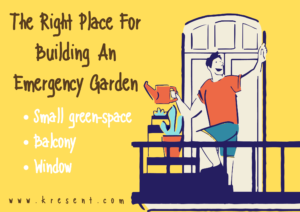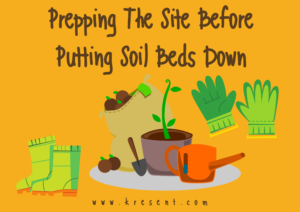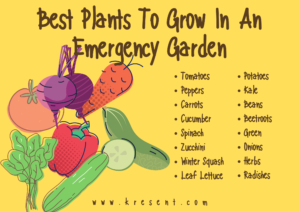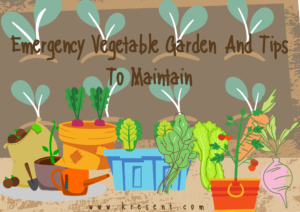Grow Your Emergency Vegetable Garden Easily
Jump To:
It is always beneficial to have some precautionary knowledge about impromptu gardening handy. Always remember that during times of crisis, even the most robust stockpile will eventually run out. But your ability to grow your own food will never leave you hungry. In this article, we will cover almost the entirety of how to grow an emergency vegetable garden, the survival garden layout. Check out plant care guide.
The Right Place For Building An Emergency Garden
If there is a place in your house or apartment exposed to the sun for about four to six hours per day, you can easily grow your food there.

Small green-space:
Even as little space as a single 8x4inches or a square area of the same is plenty for growing tons of green. For a small space in the front or back yard and patio spaces, the option of a raised soil bed is the best for emergency gardening.
Lifetime raised bed building can cost a fortune to build, and they are unnecessary if you are aiming to build just a survival garden. For that, you can use bricks to create a sturdy soil bed, and that too for very cheap. You can also repurpose materials such as wood, tires, or anything else that can hold soil.
Balcony:
Those who have a balcony can start by collecting several large containers, as big as they can find. Some container ideas are small-sized trash can, five-gallon buckets, big rectangular multi-purpose plastic containers, etc.
Next, you have to create a small hole at the bottom of the container by drilling, poking, or melting for proper drainage. If you are opting to buy new containers, you can choose from various garden pots to hanging baskets.
Window:
If you have a window with railings, then you can hang small plant pots from them. You can also build a small indoor survival garden near the window that gets plenty of sunlight. Wooden planks can also be used for making landings on or near the windows to build a small vegetable garden.
Prepping The Site Before Putting Soil Beds Down
Many make the mistake of not prepping the place which you are considering to build an emergency garden. Start by removing any sod/grass in the site where you will have the raised bed. If you have enough time in hand, you can also use a tarp or black plastic to kill the grass in the desired area by staking the plastic sheet down at the bed site and letting it cook in the sun.

Killing grasses will reduce the growth of weeds poking in your garden in the future. If you don’t have enough time for removing the grass underneath, you can choose to shovel out the sods. Once killing all sods is done, you can place your soil bed on top. For further protection, you can also put landscape fabric to prevent weed growth.
Fill Your Containers Or Raised Beds With The Right Mixture
It is important to have the right mixture for filling the containers and raised beds. One such common effective mixture is one part garden soil, one part compost, and one post vermiculite, perlite, or sand. You can find and purchase these ingredients from your local garden store.
However, if you don’t have much space or ingredients and will work in smaller soil beds or containers, you can also work with organic potting soil with home-made compost.
The Right Way To Plant
It is a common strategy to plant seeds at a depth of almost three times the diameter of the seed itself in the soil. However, when it comes to fine seeds, which are much smaller in size, they should be scattered on top of the soil and lightly pressed down.
It would be best if you never grow fruit trees on your lawn. It is because the watering and fertilization schedule of lawns will greatly vary from what actually the fruit trees will need.
Near climbing plants such as tomato, beans, peas, etc., a stake or trellises should also be planted. While planting the seeds, make sure you leave enough space near them. This is done so that you are able to weed out by moving around the plant in the future after they grow.
Best Plants To Grow In An Emergency Garden

Some of the best plants to grow in containers in case of an emergency garden are-
- Tomatoes
- Peppers
- Carrots
- Cucumber
- Spinach
- Zucchini
- Winter Squash
- Leaf Lettuce
- Potatoes
- Kale
- Beans
- Beetroots
- Green Onions
- Herbs
- Radishes
Some Advices For Maintaining Your Garden
To achieve a happy and healthy growing emergency garden, you must take the following points into account-
- It is best to water your garden every day than dumping water once a week. The vegetable gardens need about an inch of water every week. And if you have or are planning to plant them in containers, then they might need a little more water. The easiest point to remember is that if the soil feels dry, then your garden needs water.
- You will need to get rid of weeds often. Weeds growing in your garden will compete with your plants for obtaining water and nutrition, which will adversely affect your sown plants’ health. Hence, you will need to keep the soil beds weed-free. In comparison to big gardens, weeding out the emergency garden will be comparatively easy because it has a smaller bed.
- In an emergency garden, compost is the only fertilizer you will truly need. Having some good compost is handy. It is because you can use that compost to sprinkle on the base of the plant (top dress) if any of your plants look unhealthy.
- Mulch is your garden’s friend because it helps to store the moisture longer and keep the weeds down. You can put a thick layer of mulch around your established plants. People use hay/straws, wood chips, seedless grass clippings, pine shavings, newspaper, etc., as mulch.
- It is best not to leave ripe vegetables and fruits on the plants because most of them like to be picked. Make sure to pick cucumbers often, clip the herbs, harvest the beans, etc. If you leave them on the vine, then the plant will receive the signal that the season of production is over and hence will either go dormant or start to seed or, worse, die.
- Make it a habit to visit and check your garden every day. This will give you the opportunity to check on the moisture content in the soil, free your emergency garden soil of weeds, and pick green goods. It is also proven that engaging in gardening activities also improves the mental health of people.
This article has almost covered instructing about all necessary criteria for growing an emergency vegetable garden. Now you can easily grow your own food at home. I hope the information we provided has empowered you. Remember that no time is better for growing plants than starting now.
How do you layout a vegetable garden?
As a general rule, put tall veggies toward the back of the bed, mid-sized ones in the middle, and smaller plants in the front or as a border. Consider adding pollinator plants to attract beneficial insects that can not only help you get a better harvest but will also prey on garden pests.
How do I make my vegetable garden pretty?
Here are tips to help you keep your vegetable garden looking good and producing well.
- Don’t plant in rows.
- Use raised garden beds.
- Treat it like a flowerbed.
- Plan before you plant.
- Choose healthy plants.
- Choose plants that can handle drought conditions.
- Choose disease-resistant varieties.
- Play with color.
What is the best placement for a vegetable garden?
The ideal vegetable garden location is on level ground or a gentle slope. In choosing a location, avoid any low spots that stay wet in the spring. Also avoid gardening at the bottom of a slope, as air can form a frost pocket.
How do you stagger a vegetable garden?
Stagger planting times To plant in succession, you simply make smaller plantings separated by 2 to 3 weeks instead of planting everything at one time.
What vegetables can be planted together?
Easy Reference of Which Vegetables Grow Well Together Vegetable Companion Plant Cabbage Family (cabbage, broccoli, kale, Brussels sprouts) Beets, celery, dill, Swiss chard, lettuce, spinach, onions, potatoes Carrots Beans, tomatoes Celery Beans, tomatoes, cabbages Corn Cucumber, melons, squash, peas, beans, pumpkin
What plants Cannot grow together?
Other commonly believed plant incompatibilities include the following plants to avoid near one another: Mint and onions where asparagus is growing. Pole beans and mustard near beets. What Plants Should Not Be Planted Together? Asparagus. Beans. Beets. Broccoli. Cabbage. Cucumbers. Peas. Soybeans.
What month should you start a garden?
For most crops, you should start seeds indoors about six to eight weeks before the last spring frost date. In the Midwest, plant your seeds indoors in the middle to end of April. In the South, the last frost can occur as early as the beginning of February, so plant your indoor seedlines then.
How do you start a vegetable garden for beginners?
6 Essential Steps for Starting Your First Vegetable Garden Off.
- Start with a Small Space. If you’re a beginner gardener, start small.
- Grow What You Love to Eat. What do you like to eat?
- Choose the Spot for Your Garden.
- Plan Your Vegetable Garden Layout.
- Start Plants in Rich Soil.
- Be Ready for Pests and Diseases.
What are the easiest vegetables to grow?
Easiest Vegetables to Grow Yourself
- Peas.
- Radishes.
- Carrots.
- Cucumbers.
- Kale.
- Swiss Chard.
- Beets.
- Summer Squash (Zucchini) Summer squash and zucchini like well-composted soil and need plenty of space (plant them 3 to 6 feet apart in warm soil and lots of sun.)
Is morning or afternoon sun better for vegetables?
In the afternoon, the sunlight is hotter than in the morning. Around midday, when the sun is directly overhead, it is strongest. While drought-tolerant and heat-tolerant plants, such as silver and grey plants and tough woody herbs, can tolerate hot sun for 9 hours a day, most veggies would burn in those conditions.
How far should a vegetable garden be from the house?
Be sure not to put the garden too close to your house, which will cast shadows; keep planting areas at least 10 feet away from the walls. Vegetables planted in the shade are less productive and may be more susceptible to disease and insect damage than planted in full sun.
What direction should garden face?
The easiest way to tell if your garden is south facing is to stand in it, facing to the rear and use a compass or app on your phone. If the compass says ‘south’, your garden is south facing. Alternatively, if you want to know what direction a garden faces at a house you’re keen to buy, you can find out on Google Maps.
Should you succession plant tomatoes?
Succession planting is most important for determinate crops, which are crops that produce all of their fruit (or edible material) at once. Indeterminate tomatoes, cucumbers, melons, and peppers will continue to produce fruit off of the same plant, so you don’t need to worry about succession planting with these crops.
What vegetables can be planted after tomatoes?
Any legume is a good crop to rotate with tomatoes. Legumes include peas, beans, peanuts, clover, and alfalfa. These crops will help to restore nitrogen to the soil when planted after tomatoes. You can also plan for a 3, 4, or 5 year crop rotation schedule to further reduce the risk of disease.
How do you plan a garden succession planting?
Here are four techniques that can help you grow twice the food in the same amount of space — no matter where you garden.
- Pull Some, Plant Some. As soon as plants such as lettuce, spinach and peas — have passed their prime, pull them out and replant.
- Screen the Sun.
- Sow the Right Crops.

